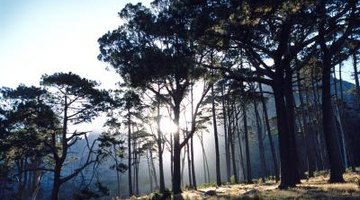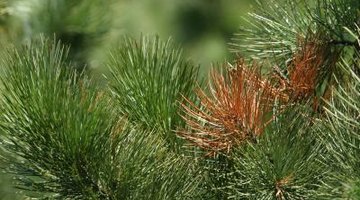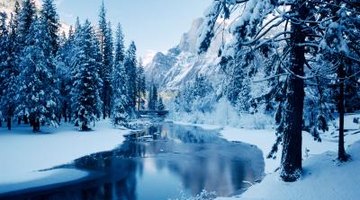Pine trees thrive in challenging environments. Growing in cold, northern climates, arid conditions and often in locations subject to frequent intense forest fires, pine trees nevertheless have evolved cunning characteristics that allow them to prevail and even dominate. They share some of these characteristics with other conifers; some are exclusive to their species.
Needles

Retaining needles for three years, as conifers do, extends the photosynthesis period but also increases water demand and water loss. Pines and other conifers have a needle structure that is assembled tightly so the vascular tissue is protected and water loss is reduced. Dense foliage reduces air movement around the needles, slowing evaporation. The needle is covered with a waxy cuticle that keeps snow from accumulating and slows transpiration. But the wax is also highly flammable.
- Retaining needles for three years, as conifers do, extends the photosynthesis period but also increases water demand and water loss.
Fire Adaptations

Pines like full sun so that shaded lower branches drop as the tree matures. This helps mature pines survive ground fires. Fires keep underbrush from outcompeting and choking out pine trees, so pines can maintain their dominance. In some species of pines, the cones will only open and release seeds in response to the intense heat of a forest fire. The ash of the forest fire provides nutrients to the soil that are conducive to the seeds of the pine.
- Pines like full sun so that shaded lower branches drop as the tree matures.
- In some species of pines, the cones will only open and release seeds in response to the intense heat of a forest fire.
Reproduction

Pine needles mature in bundles, or fascicles, of long, needle-shaped leaves wrapped at the base with short, scalelike leaves. Unusual circumstances can trigger growth of a new shoot or even roots for an entire pine tree. More typically, mature cones are shed from the tree, the cone scales separate and the winged seeds are released. Fire-resilient pines readily produce seeds in abundance and tend to have highly serotinous cones -- the cones that open in response to intense heat. Fire-resistant pines are tall, have thick bark, long needles and large seeds, and they initiate seed production slowly.
- Pine needles mature in bundles, or fascicles, of long, needle-shaped leaves wrapped at the base with short, scalelike leaves.
- Fire-resistant pines are tall, have thick bark, long needles and large seeds, and they initiate seed production slowly.
Winter Water Transport

Liquid water can be accessed by coniferous trees periodically in the winter. But the line of transport has to be unfrozen as well to move the water through the tree. Water in trees moves upward through tubelike cells in the xylem called tracheids. When this water freezes, this water column is broken. Conifer trees have evolved a response to ice formation that permits restoration of the water column instead of having to grow new xylem cells every spring.
- Liquid water can be accessed by coniferous trees periodically in the winter.
- Conifer trees have evolved a response to ice formation that permits restoration of the water column instead of having to grow new xylem cells every spring.
